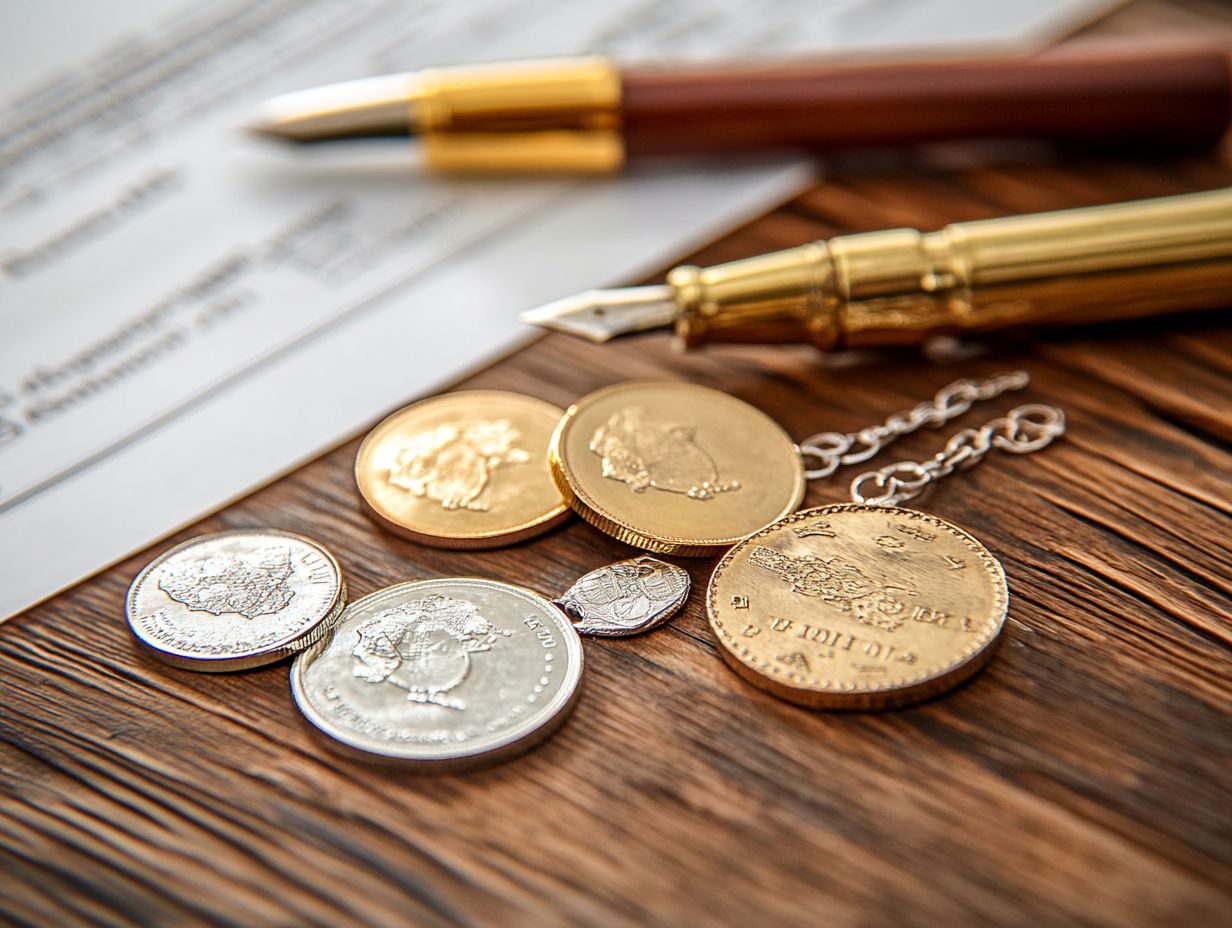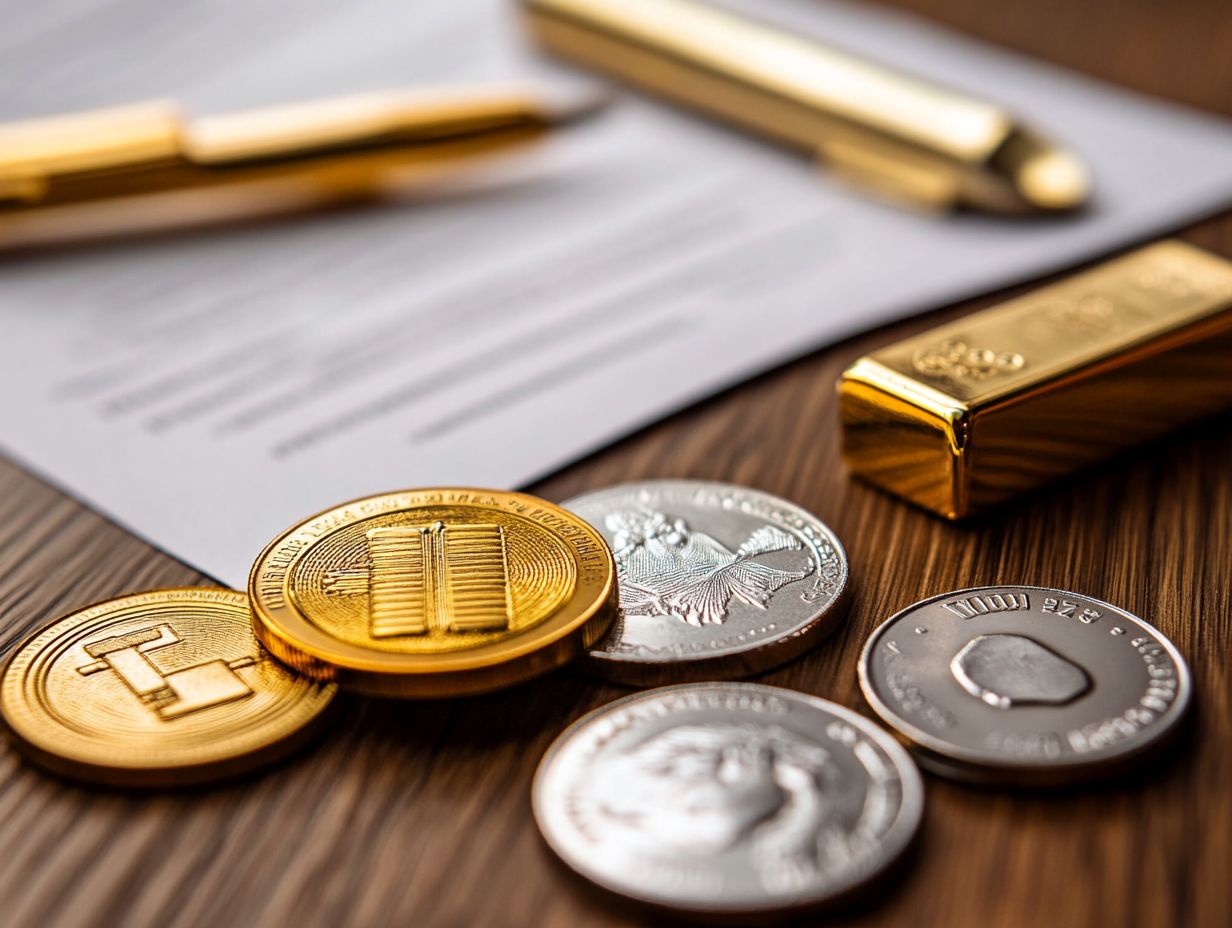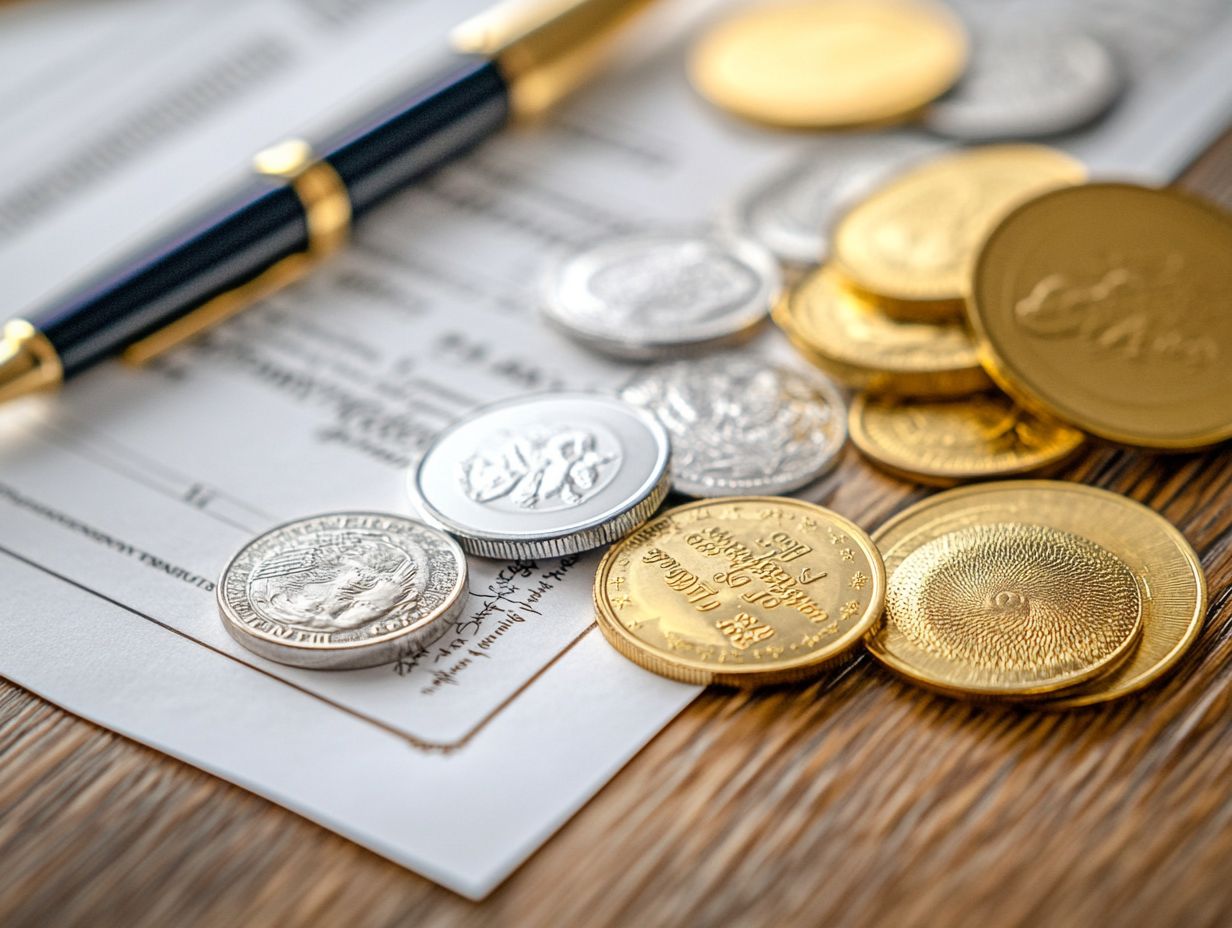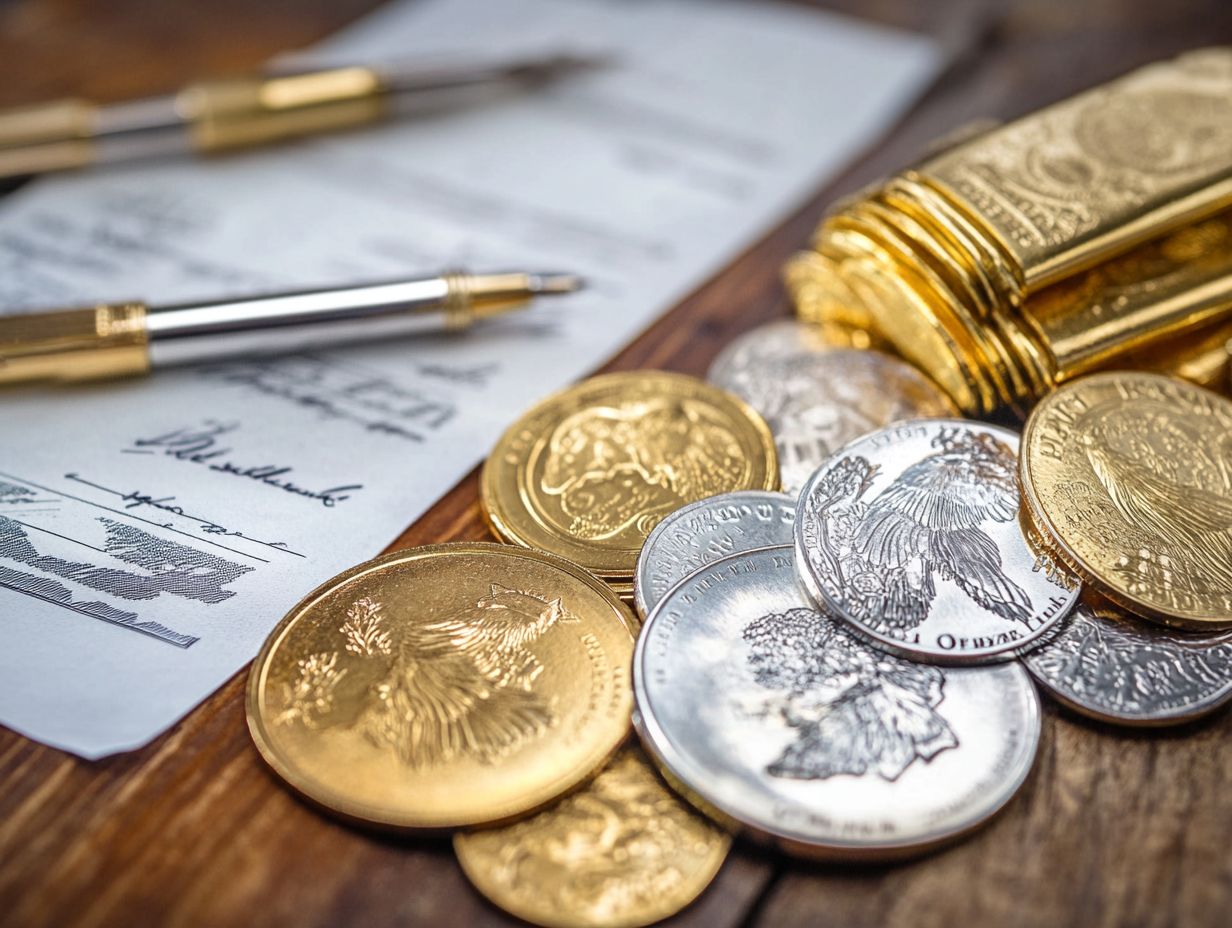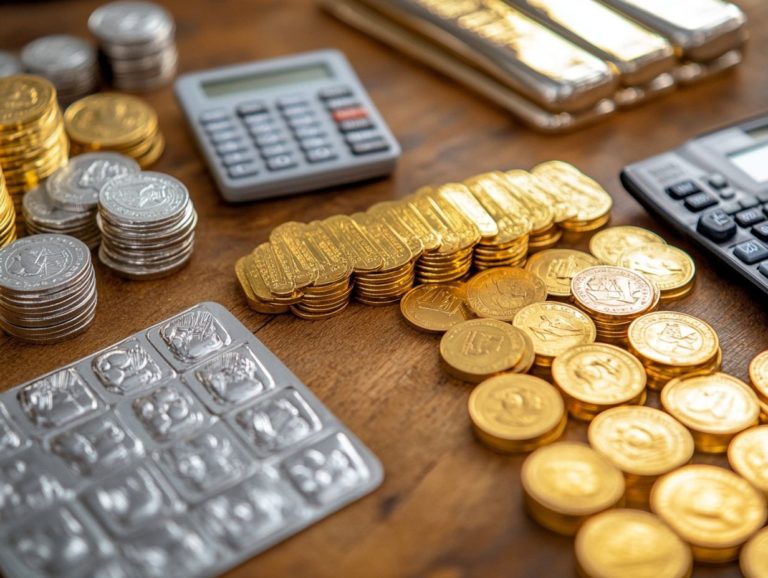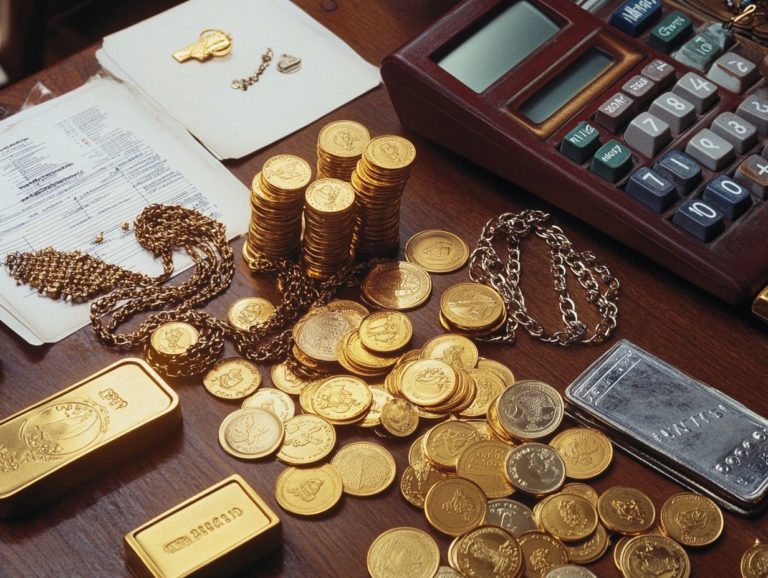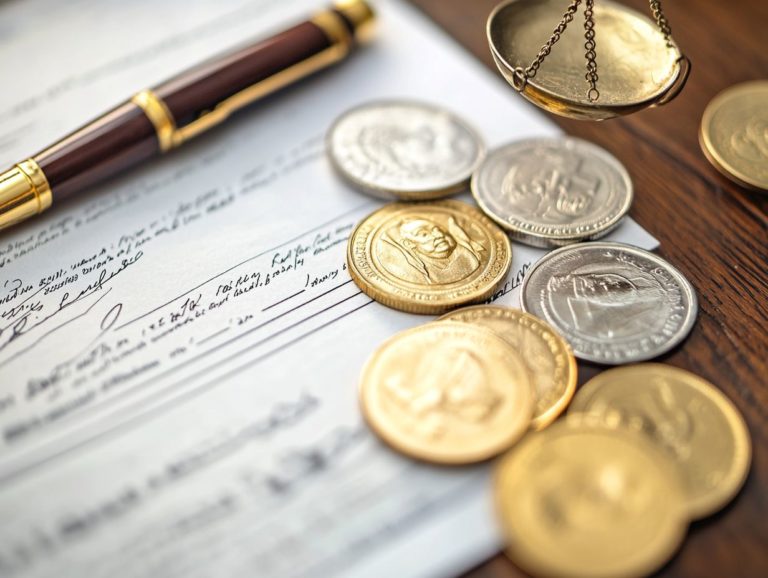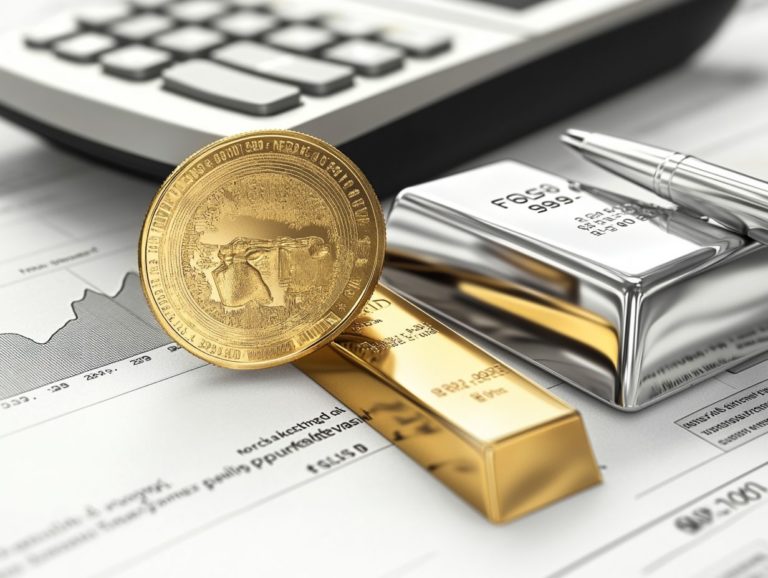The Tax Impact of Precious Metals in Estate Planning
Navigating the complexities of estate planning requires a keen understanding of the role of precious metals in your strategy. These tangible assets, like gold and silver, can significantly influence both the value of your estate and its tax implications. As you contemplate incorporating these items into your estate, it’s essential to grasp not just their market worth but also the potential tax burdens, such as inheritance, gift, and capital gains taxes.
Discover powerful strategies to minimize tax impacts and optimize your estate planning. This article will equip you with strategies to account for market fluctuations and incorporate expert advice, ensuring that your estate planning aligns seamlessly with your financial goals.
Contents
- Key Takeaways:
- The Role of Precious Metals in Estate Planning
- Tax Implications of Including Precious Metals in an Estate
- Strategies for Minimizing Tax Impact
- Factors to Consider When Including Precious Metals in an Estate
- Top Tips for Using Precious Metals in Your Estate Plan
- Frequently Asked Questions
- What is the tax impact of including precious metals in estate planning?
- How are precious metals taxed in estate planning?
- Are there any tax-saving strategies for including precious metals in estate planning?
- What is the annual gift tax exclusion and how does it apply to precious metals in estate planning?
- Are there any tax implications for inheriting precious metals?
- How can a financial advisor help with the tax impact of precious metals in estate planning?
Key Takeaways:
- Including precious metals in an estate can have significant tax implications, such as inheritance, gift, and capital gains taxes.
- Using trusts and other legal structures can help minimize the tax impact of including precious metals in an estate.
- When incorporating precious metals into estate planning, consider factors such as market volatility, liquidity, inflation, and long-term value.
The Role of Precious Metals in Estate Planning
Understanding the significance of precious metals—like gold, silver, platinum, and palladium—in your estate planning is essential for securing your wealth and making astute investment decisions. In a landscape marked by economic uncertainty, integrating these valuable assets into your portfolio can enhance its overall strength and provide strategic advantages regarding asset valuation and tax implications.
Unlike typical income options, precious metals often deliver long-term capital gains when inherited or transferred through trusts. This underscores their importance in effective estate planning.
Defining Precious Metals and Their Value
Precious metals, such as gold and silver, hold immense value due to their unique properties and market worth, making them a strategic choice for your investment portfolio. These metals have intrinsic qualities like malleability, ductility, and resistance to corrosion, which elevate their desirability for various applications beyond just currency.
Throughout history, civilizations have turned to these metals for coinage, ornaments, and as a reliable store of value during turbulent times. Today, the precious metals market is witnessing a surge in interest as investors seek stability amid uncertain economic conditions, driven by inflation and geopolitical tensions.
Unlike traditional financial securities, these metals offer a tangible asset that often retains its value, positioning them as a wise hedge against market volatility.
Tax Implications of Including Precious Metals in an Estate
In estate planning, grasping the tax implications of incorporating precious metals such as gold and silver is vital. Capital gains tax and estate taxes can profoundly influence your overall financial strategy. Understanding inheritance taxes and tax responsibilities is essential to ensure a seamless transfer of these valuable assets to your heirs.
Inheritance and Gift Taxes
Inheritance and gift taxes are pivotal in your estate planning, particularly when transferring valuable assets like gold and silver. These taxes can significantly diminish the overall value of your estate, placing an unnecessary strain on your heirs or recipients.
It’s essential to recognize that the valuation of these precious metals hinges on market rates at the time of the transfer, which can fluctuate and potentially increase your tax liabilities. Without thoughtful planning, unforeseen tax burdens could affect your financial legacy.
By employing effective estate strategies—such as utilizing annual exclusions for gifting or establishing trusts—you can minimize these taxes, ensuring a more substantial inheritance is passed on while remaining compliant with tax regulations.
Capital Gains Taxes
Capital gains taxes are important to think about when investing in precious metals. Understanding the difference between short-term and long-term capital gains can significantly shape your investment strategies.
For instance, precious metals like gold and silver often appreciate over time. This makes them appealing for long-term investors who want to benefit from lower tax rates on assets held for more than a year. By choosing to hold these assets longer, you can potentially reduce your tax burden while maximizing your returns.
You might explore strategies like dollar-cost averaging, which involves gradually investing in metals over time. This method helps smooth out market fluctuations and ideally minimizes your tax exposure by strategically timing your sales.
Ultimately, this strategy not only supports wealth accumulation but also provides a more thoughtful way to navigate the complex tax landscape.
Strategies for Minimizing Tax Impact
Implementing effective strategies to minimize tax impact in your estate planning is crucial for maximizing the value of your precious metals.
This approach ensures a smoother transfer of wealth to your heirs, particularly by utilizing trusts and consulting with knowledgeable financial advisors. By prioritizing these measures, you can protect your legacy and enhance the financial well-being of your loved ones.
Trusts and Other Legal Structures
Establishing trusts and other legal structures can be a smart move for managing precious metals within your estate. This enables effective tax planning and ensures that your wishes are honored after your passing.
Among the various types of trusts available, revocable trusts offer the flexibility to adapt to changing circumstances. In contrast, irrevocable trusts can provide significant tax benefits and protect your assets from creditors.
Special needs trusts are essential for preserving benefits for loved ones with disabilities, while charitable trusts allow you to pursue philanthropic endeavors in a tax-efficient manner.
Understanding the nuances of each trust type can greatly influence the tax implications of your estate. Collaborating with a knowledgeable financial advisor is vital, as they will help you customize these structures to your unique circumstances and objectives.
Factors to Consider When Including Precious Metals in an Estate
When considering including precious metals in your estate, it’s important to think about several key factors.
You’ll want to evaluate the market value, assess liquidity (which refers to how easily an asset can be converted into cash), and consider potential inflation effects.
Also, think about the long-term value of these investments, especially in the context of fluctuating economic conditions. Balancing these elements will help you make informed decisions that align with your overall estate strategy.
Market Volatility and Liquidity
Market volatility can greatly affect the liquidity of precious metals, impacting their overall valuation and attractiveness as financial assets within a diversified portfolio.
When financial markets become unstable, you may find yourself rushing to convert your holdings into cash, leading to fluctuating demand for assets like gold and silver. For instance, during economic downturns or geopolitical tensions, these metals often attract increased interest as safe-haven investments.
This shift can create sharp movements in their liquidity, prompting you to develop strategies that accommodate these fluctuations.
By closely monitoring market indicators and establishing predefined entry and exit points, you can better navigate the complexities introduced by market volatility. This ensures that your precious metal assets continue to serve as an effective hedge against uncertainty.
Inflation and Long-Term Value
Inflation plays an important role in shaping the long-term value of precious metals. It is essential for you to understand how these dynamics integrate into your comprehensive estate planning.
Over the years, precious metals like gold and silver have proven their resilience. They retain value even as prices rise. This enduring relationship stems from their intrinsic worth, which typically escalates when the purchasing power of currency wanes.
By diving into historical performance, it becomes evident that these metals can act as a steadfast protection against inflation. They provide stability during economic uncertainties. In your estate plan, incorporating precious metals not only diversifies your holdings but also creates a protective shield for future generations, safeguarding their assets from the relentless eroding effects of inflation.
Top Tips for Using Precious Metals in Your Estate Plan
Incorporating precious metals into your estate plan requires expert advice and smart tips from financial advisors and estate planning attorneys. This guidance helps you navigate tax responsibilities effectively and optimize your asset allocation.
Advice from Financial Experts
Experts provide essential guidance on how to seamlessly weave precious metals into your estate plan. They optimize investment strategies while ensuring compliance with tax regulations.
Begin by evaluating which types of precious metals—be it gold, silver, or platinum—align best with your unique circumstances. These metals can serve as a reliable protection against inflation and market volatility. You can also periodically review these investments, especially during economic fluctuations, to determine if any adjustments are needed.
Embracing a diversified approach when selecting metal types and utilizing secure storage solutions is crucial. This proactive management safeguards your wealth and ensures smoother transitions for future heirs, helping you align your portfolio with evolving financial goals.
Frequently Asked Questions
What is the tax impact of including precious metals in estate planning?
The tax impact of including precious metals in estate planning varies depending on the type of precious metal and its value. Generally, these assets may be subject to estate and inheritance taxes, as well as capital gains taxes.
How are precious metals taxed in estate planning?
Precious metals are typically taxed at their fair market value at the time of the owner’s death. This value may be subject to estate and inheritance taxes, which can range from 18% to 40% depending on the size of the estate. If the metals are sold, any capital gains will also be subject to taxation.
Are there any tax-saving strategies for including precious metals in estate planning?
Yes, some strategies can help minimize the tax impact of including precious metals in estate planning. These include setting up a trust, gifting the metals to heirs before death, or utilizing the annual gift tax exclusion.
What is the annual gift tax exclusion and how does it apply to precious metals in estate planning?
The annual gift tax exclusion allows individuals to gift up to a certain amount each year to another individual without incurring any gift tax. For 2021, this amount is $15,000. By gifting precious metals to heirs before death, the value of these assets can be kept below the threshold and avoid taxation.
Are there any tax implications for inheriting precious metals?
If you inherit precious metals, you may need to pay capital gains taxes on any appreciation in value since the time of the original owner’s death. However, the stepped-up basis rule may also apply. This means the cost basis for the metals will be the value at the time of inheritance, potentially reducing or eliminating capital gains taxes.
How can a financial advisor help with the tax impact of precious metals in estate planning?
Thinking about how precious metals fit into your estate plan? A financial advisor can guide you through the tax landscape, helping you save money and align your plan with your financial future.
A financial advisor can provide valuable insight into the tax implications of including precious metals in estate planning.
They can help develop strategies to minimize taxes. This ensures your estate plan aligns with your overall financial goals.



